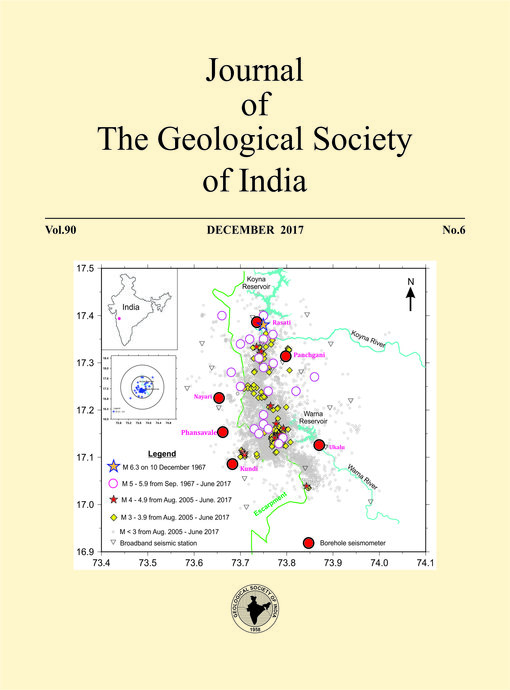Sustained Seismicity near Koyna-Warna Reservoir: A Mish-mash of Physical Processes
DOI:
https://doi.org/10.1007/s12594-017-0783-8Abstract
Earthquakes in Koyna-Warna region are triggered by the reservoirs but the reasons for sustained seismicity, in terms of magnitude and time, remain enigmatic. We critically review the proposed models/processes, which include fault interaction, flexure of Western Ghat escarpment, velocity heterogeneity, and earthquakes being considered as aftershocks. We suggest that each of these processes or models have limitations and are not capable of explaining all the features of seismicity individually. It is possible that all put together and some other unknown additional processes are at work and there is a mish-mash of several processes attending the region, causing continuing seismicity for past five decades.Downloads
Metrics
Issue
Section
Downloads
Published
How to Cite
References
Catchings, R.D., Dixit, M.M., Goldman, M.R., and Kumar, S. (2015) Structure of the Koyna-Warna Seismic Zone, Maharashtra, India: A possible model for large induced earthquakes elsewhere. Jour. Geophys. Res. Solid Earth, v.120, doi:10.1002/2014JB011695.
Catherine, J.K., Gahalaut, Kalpna and Gahalaut, V.K. (2007) Role of flexure in earthquake triggering along the Western Ghat escarpment, India. Jour. Asian Earth Sci., v.31, pp.104-111.
Catherine J.K., Gahalaut, V.K., Kundu, B., Ambikapathy, A., Yadav, R.K., Bansal, A., Narsaiah, M., and Naidu, S.M. (2015) Low deformation rate in the Koyna–Warna region, a reservoir triggered earthquake site in westcentral stable India. Jour. Asian Earth Sci., v.97, pp.1-9.
Chander, R., and Kalpna (1997) On categorising induced and natural tectonic earthquakes near new reservoirs. Engg. Geol., v.46, pp.81–92.
Dixit, M.M., Sanjay Kumar, S., Catchings, R.D., Suman, K., Sarkar, D., and Sen, M.K. (2014) Seismicity, faulting, and structure of the Koyna-Warna seismic region, Western India from local earthquake tomography and hypocenter locations. Jour. Geophys. Res., v.119, DOI: 10.1002/2014JB0 10950.
Gahalaut, V.K., Kalpna and Singh, S.K. (2004) Fault interaction and earthquake triggering in the Koyna-Warna region, India. Geophys. Res. Lett., v.31, L11614, doi:10.1029/2004GL019818.
Gahalaut, Kalpna and Gupta, P. K. (2008) An integral equation algorithm for 3-D simulation of pore pressure in a porous elastic medium with heterogeneities. Geophys. Jour. Internat., v.175, doi: 10.1111/j.1365-246X.2008.03940.x.
Gahalaut, Kalpna and Gahalaut, V.K. (2010) Effect of the Zipingpu reservoir impoundment on the occurrence of the 2008 Wenchuan earthquake and local seismicity. Geophys. Jour. Internat., v.183, pp.277-285.
Ge, S., Liu, M., Lu, N., Godt, J.W. & Luo, G. (2009) Did the Zipingpu reservoir trigger the 2008Wenchuan earthquake? Geophys. Res. Lett., v.36, L20315, doi:10.1029/2009GL040349.
Grigoli F., Cesca. S., Priolo E., Rinaldi A.P., Clinton J.F., Stabile T.A., Dost B., Garcia Fernandez M., Wiemer S. and Dahm T. (2017) Current challenges in monitoring, discrimination and management of induced seismicity related to underground industrial activities: a European perspective. Rev. Geophys., AGU, DOI:10.1002/2016RG000542.
Gunnel, Y., Fleitout, L. (2000) Morphotectonic evolution of the Western Ghats, India. In: Summerfield, M. (Ed.), Geomorphology and Global Tectonics. John Wiley and Sons Ltd, Chichester, pp.321–338.
Gupta, H.K. (2002) A review of recent studies of triggered earthquakes by artificial water reservoirs with special emphasis on earthquakes in Koyna, India. Earth Sci. Rev., v.58, pp.279-310.
Gupta, H.K., Rao, N.P., Roy, S., Arora, K., Tiwari, V.M., Patro, P.K., Satyanarayan, H.V.S., Shashidhar, D., Mallika, K., Vyasulu, V., Akkiraju, Goswami, D., Vyas, D., Ravi, G., Srinivas, K.N.S.S.S., Srihari, M., Mishra, S., Dubey, C.P., Raju, C.V., Borah, U., Reddy, K.C., Babu, N., Rohilla, S., Dhar, U., Sen, M.K., Rao, Y.J.B., Bansal, B.K., Nayak, S. (2015) Investigations related to scientific deep drilling to study reservoir triggered earthquakes at Koyna, India. Internat. Jour. Earth Sci., v.104(6), pp.1511–1522.
Kerr, R.A. and Stone, R. (2009) A human trigger for the great quake of Sichuan? Science, v.323, pp.322.
Klose, C.D. (2008) The 2008 M7.9 Wenchuan earthquake – result of local and abnormal mass imbalances? AGU Fall meeting, U21C-08.
McGarr, A. & Simpson, D. (1997) Keynote lecture: a broad look at induced seismicity, in Rockbursts and Seismicity in Mines, pp. 385–396, Balkema, Rotterdam.
Minato, S., Tsuji, T., Ohmi, S. and Matsuoka, T. (2012) Monitoring seismic velocity change caused by the 2011 Tohoku-oki earthquake using ambient noise records, Geophys. Res. Lett., v.39, L09309, doi:10.1029/2012GL 051405.
Parsons, T. (2009) Lasting earthquake legacy, Nature, v.462, pp.42-43.
Perfettini, H., Avouac, J.P. and Ruegg, J.C. (2005) Geodetic displacements and aftershocks following the 2001 Mw = 8.4 Peru earthquake: Implications for the mechanics of the earthquake cycle along the subduction zones. Jour. Geophys. Res., v.109, B09404, doi: 10.1029/2004JB003522.
Rai, S.S., et al. (1999) What triggers Koyna earthquakes? Preliminary results from seismic tomography digital array, Proc Indian Academy of Sciences (Earth and Planetary Science), v.108, pp.1–14.
Rao, N.P., and Shashidhar, D. (2016) Periodic variation of stress field in the Koyna–Warna reservoir triggered seismic zone inferred from focal mechanism studies. Tectonophysics, v.679, pp.29–40.
Simpson, D.W. (1986) Triggered earthquakes. Annual Review of Earth and Planetary Sciences, v.14, pp.21-42.
Singh, S.K. (2003) Seismic imaging and tectonics of Koyna seismic zone, Ph.D. thesis, Osmania Univ., Hyderabad, India.
Stein, S. and Liu, M. (2009) Long aftershock sequences within continents and implications for earthquake hazard assessment. Nature, v.462, pp.87-89.
Srinagesh, D., Singh, S., Srinath, K.R., Prakasam, K.S. and Rai, S.S. (2000) Evidence for high velocity in Koyna seismic zone from P-wave teleseismic imaging. Geophys. Res. Lett., v.27, pp.2737-2740.
Shearer, P. M., and Philip B.S., (2012) Global risk of big earthquakes has not recently increased, PNAS, v.109, pp.717–721.
Stein S., and Liu, M. (2009) Long aftershock sequences within continents and implications for earthquake hazard assessment. Nature, v.462, doi:10.1038/nature08502.
Talwani, P., Kumarswamy, S.V. and Sawalwede, C.B. (1996) The re-evaluation of seismicity data in the Koyna-Warna area, Report of Univ. of South Carolina, South Carolina, USA.

 Kalpna Gahalaut
Kalpna Gahalaut






